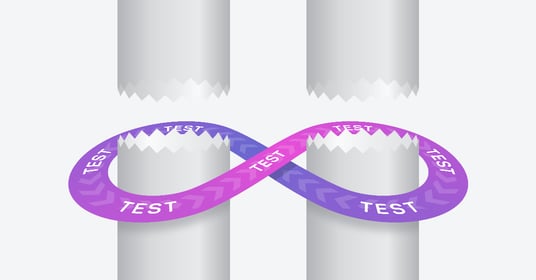Get a Free Trial
Creating, executing, and maintaining reliable tests has never been easier.
Collaboration is essential for scaling DevOps sustainably, especially when it comes to building a quality-centric development pipeline that accelerates product velocity and improves the customer experience. And few areas present a stronger opportunity for collaboration than testing, which connects code to customers. As delivery cycles shift to a faster cadence, testing teams need solutions that empower them to adopt DevOps best practices for better collaboration.
Mabl is making some of these best practices more accessible to all software testing teams through low-code enhanced branching, version control, and peer review. Traditionally adopted more widely by developers, low-code enables everyone engaged in testing to share these processes for more collaborative, higher quality development pipelines.
Collaborative Testing is Central to DevOps Adoption
Mabl’s Testing in DevOps Report revealed the power of collaborative testing. Software development teams who considered testing a shared responsibility across the organization were significantly more likely to have mature DevOps practices and automated pipelines.
These organizations likely practice collaborative testing, where quality is a shared responsibility and everyone contributes to testing with a common set of tools, processes, and goals. Collaborative testing supports a seamless transition between testers, developers, and product owners as code moves through the SDLC, minimizing the time needed to find and resolve bugs. Mabl makes it easier to adopt collaborative testing with low-code enhanced branching, version control, and peer review for automated tests.
Test Branching Enables Shift-Left
Branching is a common DevOps practice where developers create new iterations of a piece of code in order to work on separate projects simultaneously. It enables development teams to experiment with bug fixes, new features, or product enhancements without impacting other projects or customer-facing environments. Each iteration can then be tested and later merged into the main branch once the new addition is ready.
Though branching is a core practice in DevOps and CI/CD pipelines, many software testing teams haven’t been able to adopt it due to time constraints and tool limitations. Low-code branching in mabl removes these obstacles as anyone on the testing team can create a branched test that can be updated without impacting the main test.
Create a new test branch in just a few clicks with mabl
This allows quality engineers to create updated tests for new features earlier in the development cycle, simplifying shift-left and better aligning testing with development. Disparate versions of tests can be resolved later in development just like branching in developer workflows.
Share Software Testing Knowledge with Peer Reviews
Collaborative testing requires consistent strategies for sharing testing knowledge with quality professionals, developers, product owners, and anyone else engaged in testing. As test branching becomes common practice for a quality engineering team, being able to review and discuss test changes is essential for quality collaboration.
Mabl’s enhanced branching features enable teammates to create and resolve comment threads directly on tests or flows for easy alignment on changes. Rather than coordinating discussions across disconnected toolsets, conversations are centralized in the branch details so everyone has the context to contribute.
Change tracking unlocks collaborative testing for high-velocity teams
As testing scales across the SDLC and the entire software development organization, test review ensures that everyone has access to the most recent version of each test branch and can easily share their expertise, ultimately improving test reliability and maximizing everyone’s skills.
Software Testing is a Team Sport in DevOps
Collaborative testing ensures that everyone - testers, developers, and product owners - are aligned on quality goals and processes at every stage of the DevOps pipeline. With low-code branching, version control, and peer review from mabl, high-velocity software teams can sustainably adopt collaborative testing and empower their teams to mature their DevOps practices.
Experience the low-code testing difference with mabl’s 14-day free trial. Discover how quickly your quality team can start adopting collaborative testing and transform your DevOps pipeline.






